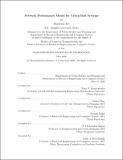Network performance model for urban rail systems
Author(s)
Mo, Baichuan.
Download1193557026-MIT.pdf (6.084Mb)
Other Contributors
Massachusetts Institute of Technology. Department of Urban Studies and Planning.
Massachusetts Institute of Technology. Department of Electrical Engineering and Computer Science.
Advisor
Haris N. Koutsopoulos, Jinhua Zhao, and Patrick Jaillet.
Terms of use
Metadata
Show full item recordAbstract
Urban rail transit is an important component of transportation systems and plays a critical role in providing smooth and efficient mobility in many metropolitan areas. Network performance monitoring, i.e. assessing the level of service and operation information of the network (e.g. train loads), is a fundamental task for urban rail transit management. The objective of this thesis is to develop a data-driven network performance model (NPM) for urban rail system performance monitoring. Specifically, this work focuses on two major components of the NPM: 1) a network loading engine which takes train movement data, origin-destination (OD) flows, network, train capacity, and path choices as inputs, and outputs performance indicators such as train loads and crowding levels, and 2) a calibration engine which can estimate path choice and train capacity parameters using automatically collected data. The automated fare collection (AFC) and train movement data from Hong Kong's Mass Rail Transit (MTR) network are used as a case study for the analysis. An event-based network loading engine is proposed. The model can distribute passengers in the network given OD demand, path choices, train capacity with a capacity constraint, and a first-come-first-board criterion. The event-based is computationally efficient while retaining the necessary performance information, which enables it to be applied with largescale urban rail systems. An effective train capacity model is proposed, which assumes that train capacity is a function of train load and number of queuing passengers on platforms. The model recognizes that train capacity may vary across stations, which is seldom considered in the literature. The use of NPM for performance monitoring is demonstrated by analyzing the spatial-temporal crowding patterns in the MTR system and evaluating dispatching strategies. The model is validated by comparing its outputs (with effective capacity) with field observations at a busy station and the outputs of a benchmark fixed-capacity model. Results show that the output of the model matches the ground truth observations well and outperform the benchmark model. NPM is also used to identify crowding stations and evaluate different dispatching strategies. To calibrate path choices, an assignment-based path choice estimation framework using AFC data is proposed. The framework captures the crowding correlation among stations and the interaction between path choices and passenger denied boarding, which are usually neglected in the literature. The path choice estimation is formulated as an optimization problem, which attempts to minimize the error between assignment outputs (which is a function of path choices) and the corresponding quantities observed from the AFC data. The original problem is intractable because of a non-linear multinomial logit equation constraint. and a non-analytical black-box function constraint (i.e. assignment model). A solution procedure is proposed to decompose the original problem into three tractable sub-problems: rough path shares estimation, choice parameters estimation, and path exit rates estimation. The sub-problems can all be solved efficiently. We prove the solution of the decomposed problem is equivalent to the original problem under certain conditions. The model is validated using both synthetic data and real-world AFC data. Results from synthetic data show estimated path choice parameters are very close to the "true" (synthetic) ones. The proposed method outperforms the benchmark models in both the convergence rate and final solutions quality. Results from real-world data show the estimated coefficients are similar to the previous survey results. The model's robustness is verified through a sensitivity analysis. As the observed information in AFC data may also be affected by train capacity, a simultaneous calibration of path choices and train capacity is more reasonable than calibrating one set of parameters alone. We propose a simulation-based optimization (SBO) framework to calibrate path choices and train capacity simultaneously using AFC and train movement data. The calibration problem is formulated as an optimization problem with a black-box objective function. Seven optimizers (solving algorithms) from four brunches of SBO solving methods are evaluated. The algorithms are evaluated using an experimental design that includes five scenarios, representing different degrees of path choice randomness and crowding sensitivity. Results show that some of the algorithms can estimate the path choice and train capacity parameters well. In general, the response surface methods have better convergence speed, stability, and estimation accuracy. They exhibit consistently good performance under all scenarios. Future research directions include: 1) Developing a more efficient simultaneous path choices and train capacity calibration framework. The proposed SBO framework in this work is not computationally efficient due to a large number of expensive simulation-based function evaluations. Modifying the assignment-based framework to incorporate co-calibration is an interesting direction. 2) Developing a behavior-based effective train capacity model that incorporates passengers' willingness to board explicitly. 3) Extending the NPM for realtime operation control and future planning. A reinforcement learning-based control engine and an automated timetable design engine can be added to the current NPM framework to enable control and planning applications, respectively.
Description
Thesis: S.M. in Transportation, Massachusetts Institute of Technology, Department of Urban Studies and Planning, 2020 Thesis: S.M., Massachusetts Institute of Technology, Department of Electrical Engineering and Computer Science, May, 2020 Cataloged from the official PDF of thesis. Includes bibliographical references (pages 99-104).
Date issued
2020Department
Massachusetts Institute of Technology. Department of Urban Studies and Planning; Massachusetts Institute of Technology. Department of Electrical Engineering and Computer SciencePublisher
Massachusetts Institute of Technology
Keywords
Urban Studies and Planning., Electrical Engineering and Computer Science.